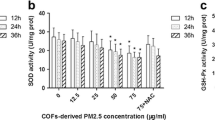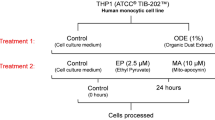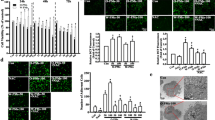Abstract
Cooking oil fumes (COFs) are the major sources of indoor air pollution in Asia. It is well known that alveolar cells are key participants in the development of respiratory system; however, it still remains unknown whether alveolar cells are affected by COFs. Therefore, the present study investigated the effects of COFs on alveolar cells (A549 cells) and illuminated its apoptotic mechanism in response to COF-PM2.5 exposure. When A549 cells were exposed to COF-PM2.5, cell viability was substantially decreased, while the generation of ROS increased, and LDH levels and CCK-8 levels gradually changed within a dose-dependent manner. The nitrite concentration in the supernatants was augmented, while the SOD activity and GSH recycling were decreased upon COF-PM2.5. Moreover, COF-PM2.5 treatment increased mRNA levels of COX-2, inducible NO synthase, and TNF-α, and Elisa assay suggested that secretory proteins IL-6 and TNF-α were also increased. Furthermore, the Bax/Bcl-2 mRNA ratio was increased, and cleaved caspase-3 protein was activated in the A549 cells. Strikingly, COF-PM2.5 induced the phosphorylation of STAT1 at Tyr701/Ser727 and activation of NF-кB and ERK1/2, p38, and JNK of the MAPK pathway. In short, our study suggested that COF-PM2.5 resulted in inflammation, apoptosis, and cell damage in A549 cells, which might be modulated via the activation of MAPK/NF-кB/STAT1 pathway.







Similar content being viewed by others
References
Abbas I, Verdin A, Escande F, Saint-Georges F, Cazier F, Mulliez P, Courcot D, Shirali P, Gosset P, Garçon G (2016) In vitro short-term exposure to air pollution PM2.5-0.3 induced cell cycle alterations and genetic instability in a human lung cell coculture model. Environ Res 147:146–158. https://doi.org/10.1016/j.envres.2016.01.041
Ando T, Komatsu T, Naiki Y, Yokochi T, Watanabe D, Koide N (2015) Pretreatment of LPS inhibits IFN-β-induced STAT1 phosphorylation through SOCS3 induced by LPS. Biomed Pharmacother 76:1–5. https://doi.org/10.1016/j.biopha.2015.10.019
Astort F, Sittner M, Ferraro SA, Orona NS, Maglione GA, De la Hoz A, Tasat DR (2013) Pulmonary inflammation and cell death in mice after acute exposure to air particulate matter from an industrial region of Buenos Aires. Arch Environ Con Tox 67:87–96
Boucherat O, Morissette MC, Provencher S, Bonnet S, Maltais F (2016) Bridging lung development with chronic obstructive pulmonary disease. Relevance of developmental pathways in chronic obstructive pulmonary disease pathogenesis. Am J Resp Crit Care Med 193(4):362–375. https://doi.org/10.1164/rccm.201508-1518PP
Cao J, Ding R, Wang Y, Chen D, Guo D, Liang C, Feng Z, Che Z (2013) Toxic effect of cooking oil fumes in primary fetal pulmonary type II-like epithelial cells. Environ Toxicol Phar 36(2):320–331. https://doi.org/10.1016/j.etap.2013.04.011
Cao J, Qin G, Shi R, Bai F, Yang G, Zhang M, Lv J (2016a) Overproduction of reactive oxygen species and activation of MAPKs are involved in apoptosis induced by PM2.5 in rat cardiac H9c2 cells. J Appl Toxicol 36:609–617
Cao Z, Lis R, Ginsberg M, Chavez D, Shido K, Rabbany SY, Fong G-H, Sakmar TP, Rafii S, Ding B-S (2016b) Targeting of the pulmonary capillary vascular niche promotes lung alveolar repair and ameliorates fibrosis. Nat Med 22(2):154–162. https://doi.org/10.1038/nm.4035
Ding X, Wang M, Chu H, Chu M, Na T, Wen Y, Wu D, Han B, Bai Z, Chen W, Yuan J, Wu T, Hu Z, Zhang Z, Shen H (2014) Global gene expression profiling of human bronchial epithelial cells exposed to airborne fine particulate matter collected from Wuhan, China. Toxicol Lett 228(1):25–33. https://doi.org/10.1016/j.toxlet.2014.04.010
Gaestel M (2015) MAPK-activated protein kinases (MKs): novel insights and challenges. Front Cell Dev Biol 3:88
Hou Y, Liu M, Husted C, Chen C, Thiagarajan K, Johns JL, Rao SP, Alvira CM (2015) Activation of the nuclear factor-κB pathway during postnatal lung inflammation preserves alveolarization by suppressing macrophage inflammatory protein-2. Am J Physiol-lung C 309(6):L593–L604. https://doi.org/10.1152/ajplung.00029.2015
Huff MO, Todd SL, Smith AL, Elpers JT, Smith AP, Murphy RD, Bleser-Shartzer AS, Hoerter JE, Radde BN, Klinge CM (2016) Arsenite and cadmium activate MAPK/ERK via membrane estrogen receptors and G-protein coupled estrogen receptor signaling in human lung adenocarcinoma cells. Toxicol Sci 152(1):62–71. https://doi.org/10.1093/toxsci/kfw064
Jalmi SK, Sinha AK (2015) ROS mediated MAPK signaling in abiotic and biotic stress—striking similarities and differences. Front Plant Sci 6(769). https://doi.org/10.3389/fpls.2015.00769
Kanter JA, Sun H, Chiu S, DeCamp MM, Sporn PHS, Sznajder JI, Bharat A (2015) Decreased CXCL12 is associated with impaired alveolar epithelial cell migration and poor lung healing after lung resection. Surgery 158(4):1073–1082. https://doi.org/10.1016/j.surg.2015.04.051
Kato T, Oka K, Nakamura T, Ito A (2015) Bronchioalveolar morphogenesis of human bronchial epithelial cells depending upon hepatocyte growth factor. J Cell Mol Med 19(12):2818–2826. https://doi.org/10.1111/jcmm.12672
Kumar M, Singh RS, Banerjee T (2015) Associating airborne particulates and human health: exploring possibilities. Environ Int 84:201–202. https://doi.org/10.1016/j.envint.2015.06.002
Lee H, Park JR, Kim EJ, Kim WJ, Hong SH, Park SM, Yang SR (2016) Cigarette smoke-mediated oxidative stress induces apoptosis via the MAPKs/STAT1 pathway in mouse lung fibroblasts. Toxicol Lett 240(1):140–148. https://doi.org/10.1016/j.toxlet.2015.10.030
Li M-H, Fan L-C, Mao B, Yang J-W, Choi AMK, Cao W-J, Xu J-F (2016) Short-term exposure to ambient fine particulate matter increases hospitalizations and mortality in COPD. Chest 149(2):447–458. https://doi.org/10.1378/chest.15-0513
Li R, Kou X, Geng H, Xie J, Yang Z, Zhang Y, Cai Z, Dong C (2015) Effect of ambient PM2.5 on lung mitochondrial damage and fusion/fission gene expression in rats. Chem Res Toxicol 28(3):408–418. https://doi.org/10.1021/tx5003723
Liu Y, Chen YY, Cao JY, Tao FB, Zhu XX, Yao CJ, Chen DJ, Che Z, Zhao QH, Wen LP (2015) Oxidative stress, apoptosis, and cell cycle arrest are induced in primary fetal alveolar type II epithelial cells exposed to fine particulate matter from cooking oil fumes. Environ Sci Pollut R 22(13):9728–9741. https://doi.org/10.1007/s11356-015-4140-4
Long JF, Waldman WJ, Kristovich R, Williams M, Knight D, Dutta PK (2005) Comparison of ultrastructural cytotoxic effects of carbon and carbon/iron particulates on human monocyte-derived macrophages. Environ Health Persp 113:170–174
McQualter JL, Anthony D, Bozinovski S, Prele CM, Laurent GJ (2014) Harnessing the potential of lung stem cells for regenerative medicine. Int J Biochem Cell B 56:82–91. https://doi.org/10.1016/j.biocel.2014.10.012
Pardo M, Porat Z, Rudich A, Schauer JJ, Rudich Y (2015) Repeated exposures to roadside particulate matter extracts suppresses pulmonary defense mechanisms, resulting in lipid and protein oxidative damage. Environ Pollut 210:227–237
Potera C (2014) Toxicity beyond the lung: connecting PM2.5, inflammation, and diabetes. Environ Health Persp 122(1):A29. https://doi.org/10.1289/ehp.122-A29
Profita M, Albano GD, Montalbano AM, Di Sano C, Anzalone G, Gagliardo R, Riccobono L, Bonanno A, Siena L, Pieper MP, Gjomarkaj M (2013) Acetylcholine leads to signal transducer and activator of transcription 1 (STAT-1) mediated oxidative/nitrosative stress in human bronchial epithelial cell line. Bba-mol Basis Dis 1832(12):1949–1958. https://doi.org/10.1016/j.bbadis.2013.06.009
Profita M, Sala A, Bonanno A, Riccobono L, Ferraro M, La Grutta S, Albano GD, Montalbano AM, Gjomarkaj M (2010) Chronic obstructive pulmonary disease and neutrophil infiltration: role of cigarette smoke and cyclooxygenase products. Am J Phys Lung Cell Mol Phys 298(2):L261–L269. https://doi.org/10.1152/ajplung.90593.2008
Renda T, Baraldo S, Pelaia G, Bazzan E, Turato G, Papi A, Maestrelli P, Maselli R, Vatrella A, Fabbri LM, Zuin R, Marsico SA, Saetta M (2008) Increased activation of p38 MAPK in COPD. Eur Rrespir J 31(1):62–69. https://doi.org/10.1183/09031936.00036707
Sancini G, Farina F, Battaglia C, Cifola I, Mangano E, Mantecca P, Camatini M, Palestini P (2014) Health risk assessment for air pollutants: alterations in lung and cardiac gene expression in mice exposed to Milano winter fine particulate matter (PM2.5). PLoS One 9(10):e109685. https://doi.org/10.1371/journal.pone.0109685
Schlesinger RB (2007) The health impact of common inorganic components of fine particulate matter (PM2.5) in ambient air: a critical review. Inhal Toxicol 19(10):811–832. https://doi.org/10.1080/08958370701402382
Siegrist S, Kettiger H, Fasler-Kan E, Huwyler J (2017) Selective stimulation of the JAK/STAT signaling pathway by silica nanoparticles in human endothelial cells. Toxicol in Vitro 42:308–318. https://doi.org/10.1016/j.tiv.2017.05.002
Taylor CA, Zheng Q, Liu Z, Thompson JE (2013) Role of p38 and JNK MAPK signaling pathways and tumor suppressor p53 on induction of apoptosis in response to Ad-eIF5A1 in A549 lung cancer cells. Mol Cancer 12(1):35. https://doi.org/10.1186/1476-4598-12-35
Wang YZ, Ingram JL, Walters DM, Rice AB, Santos JH, Van Houten B, Bonner JC (2003) Vanadium-induced STAT-1 activation in lung myofibroblasts requires H2O2 and P38 MAP kinase. Free Radical Bio Med 35(8):845–855. https://doi.org/10.1016/S0891-5849(03)00399-X
Yang L, Liu G, Lin Z, Wang Y, He H, Liu T, Kamp DW (2014) Pro-inflammatory response and oxidative stress induced by specific components in ambient particulate matter in human bronchial epithelial cells. Environ Toxicol 31:923–936
Funding
This work was partially supported by Anhui Provincial Natural Science Fundation (No. 1208085MB26) and the Environmental Protection Public Welfare Scientific Research Project, Ministry of Environmental Protection of the People’s Republic of China (No. 201009041).
Author information
Authors and Affiliations
Corresponding author
Additional information
Responsible editor: Philippe Garrigues
Rights and permissions
About this article
Cite this article
Dou, C., Zhang, J. & Qi, C. Cooking oil fume-derived PM2.5 induces apoptosis in A549 cells and MAPK/NF-кB/STAT1 pathway activation. Environ Sci Pollut Res 25, 9940–9948 (2018). https://doi.org/10.1007/s11356-018-1262-5
Received:
Accepted:
Published:
Issue Date:
DOI: https://doi.org/10.1007/s11356-018-1262-5




